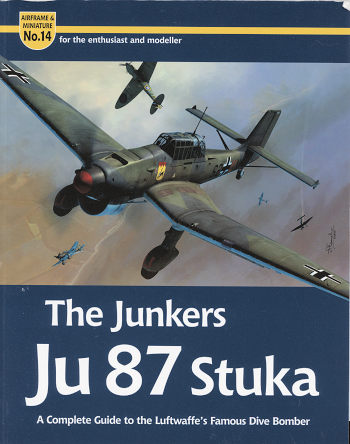 Thanks to the
situation with international mails at this time. This book arrived a couple of
weeks after AM #15. I'm glad it did show as it is another superb book from the
folks at Valiant Wings. The German air force had put a lot of faith in the dive
bomber, thanks to Edward Milch, who was enamored with the type. Indeed, if you
wanted pin-point accuracy in terms of hitting a target, then dive bombing was
the way to do it. The opening months of the war in Europe and the war in the
Pacific proved that without a doubt. However, for a dive bomber to be properly
effective, the nation operating it needs air superiority as these planes are
pretty much sitting ducks for defending fighters.
Thanks to the
situation with international mails at this time. This book arrived a couple of
weeks after AM #15. I'm glad it did show as it is another superb book from the
folks at Valiant Wings. The German air force had put a lot of faith in the dive
bomber, thanks to Edward Milch, who was enamored with the type. Indeed, if you
wanted pin-point accuracy in terms of hitting a target, then dive bombing was
the way to do it. The opening months of the war in Europe and the war in the
Pacific proved that without a doubt. However, for a dive bomber to be properly
effective, the nation operating it needs air superiority as these planes are
pretty much sitting ducks for defending fighters.
It is interesting that when the competition for a dive
bomber in which the Ju-87 was entered was complete, the He-118 was determined to
be the winner. However, politicking took over and the Ju-87 was the type put
into production.
The initial production aircraft was different from the
prototype in that it had a standard tail section. It was still underpowered and
could only carry a maximum bomb load if it left the gunner at home. Still,
planes sent to Spain showed that the plane was effective in the conditions
there.
After the initial production planes were build, an
improved version was developed, learning from the experience in Spain. It was
with the Ju-87B that Germany went to war. The type was very effective in the
first 10 months of the war, however, once it was sent into the skies over the
UK, it became woefully obvious that it was little more than easy pickings for
the RAF and was quickly pulled out of that theater.
In Russia, it was a bit of a different situation. In the
beginning, the Stuka was again effective as the Luftwaffe made it easy to get
local air superiority. Failure of any sort of replacement provided another
upgrade to the airframe, one which lasted until the end of the war.
This latest volume from Valiant Wings provides a full
development history and a fair combat history. It details the differences in
sub-variants, which were considerable considering the length of time it was
produced. You are provided with a nice colors and markings section along with
the type's use in foreign countries.
Then we get a modeling section that provides some kit
reviews. This section only covers a minimal number of those kits that have been
fairly new releases. This is followed by the build articles. Oddly, several of
the build articles are on kits not listed in the review section. As usual the
1/72 builder likes lots of aftermarket while the builder of the 1/48 and 1/32
kits leans more to basically out of the box. This leads to the closeup section
that combines period photos and tech manual illustrations with images from
preserved aircraft. Finally, a section that provides all the kits, decals,
aftermarket, and books done on the Stuka. To add to the desirability of this
book, two very large foldouts of plans in 1/48 scale.
It goes without saying, but I'll say it anyway, that
this series is undoubtedly one of the best done when it comes to completeness in
regards to covering a subject for both the enthusiast and the modeler.
August 2020
Copyright ModelingMadness.com. All rights reserved.
Thanks to
Valiant Wings for the review copy. You can get yours today
at
this link.
If you would like your product reviewed fairly and
fairly quickly, please
contact
the editor or see other details in the
Note to
Contributors.
 Thanks to the
situation with international mails at this time. This book arrived a couple of
weeks after AM #15. I'm glad it did show as it is another superb book from the
folks at Valiant Wings. The German air force had put a lot of faith in the dive
bomber, thanks to Edward Milch, who was enamored with the type. Indeed, if you
wanted pin-point accuracy in terms of hitting a target, then dive bombing was
the way to do it. The opening months of the war in Europe and the war in the
Pacific proved that without a doubt. However, for a dive bomber to be properly
effective, the nation operating it needs air superiority as these planes are
pretty much sitting ducks for defending fighters.
Thanks to the
situation with international mails at this time. This book arrived a couple of
weeks after AM #15. I'm glad it did show as it is another superb book from the
folks at Valiant Wings. The German air force had put a lot of faith in the dive
bomber, thanks to Edward Milch, who was enamored with the type. Indeed, if you
wanted pin-point accuracy in terms of hitting a target, then dive bombing was
the way to do it. The opening months of the war in Europe and the war in the
Pacific proved that without a doubt. However, for a dive bomber to be properly
effective, the nation operating it needs air superiority as these planes are
pretty much sitting ducks for defending fighters.